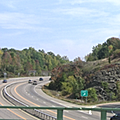- By Office of the New York State Comptroller
- News
 Print
Print  Despite cost control efforts and increased state financial assistance, the New York State Thruway Authority will continue to face fiscal challenges, according to an audit released today by New York State Comptroller Thomas P. DiNapoli. The Comptroller recommended the authority develop and implement a long term capital plan given that its current revenue structure may not be sufficient to cover ongoing and future capital needs.
Despite cost control efforts and increased state financial assistance, the New York State Thruway Authority will continue to face fiscal challenges, according to an audit released today by New York State Comptroller Thomas P. DiNapoli. The Comptroller recommended the authority develop and implement a long term capital plan given that its current revenue structure may not be sufficient to cover ongoing and future capital needs."The Thruway Authority should develop a better roadmap for the future," DiNapoli said. "In addition to the Tappan Zee bridge replacement, many of the Thruway Authority's aging roads and bridges require significant work or repair. Thruway officials need to come up with a viable plan to make ends meet for the long term and clearly lay out how it will affect New York drivers and taxpayers."
The Thruway Authority is responsible for overseeing and maintaining the Thruway, a 570-mile tolled highway system. Since 1992, the authority has also had control of the 524-mile New York State Canal System.
During parts of the past decade, auditors note the Thruway's fiscal condition declined, as noted in reports by authority consultants. Responsibility for maintenance costs of additional roads put a major strain on the Thruway, and traffic fell by more than 10 percent between 2005 and 2011. In addition, the authority continued to bear costs associated with the canal system, which had operating expenses of $62.1 million compared to revenues of $2.4 million in 2015.
In addition, after examining the Thruway's finances from January 2012 to January 2016, DiNapoli's auditors found that while the authority's financial statements indicate that current operating revenues were sufficient to cover its day-to-day operating expenses, there is considerable risk that revenues will fall short of future needs.
A prior DiNapoli audit issued in January 2008 identified several areas where the Thruway could increase revenues, such as collecting delinquent tolls and evaluating additional means of raising revenue through private sector advertising and sponsorships. The report also noted the authority had not performed an analysis of areas where costs could be reduced, nor had it prioritized projects on future capital plans to identify non-essential projects that could be deferred.
Since then the Thruway has generally held operating expenses to budgeted amounts. Additionally, from 2010 through 2014, the authority's operating expenses dropped by 8.5 percent, while its revenues increased 3.6 percent.
The Thruway has reduced personal service costs and spending on both capital projects and motorized equipment. It has also implemented a system to reduce toll evasion and looked for other ways to generate revenue. From 2010 through 2014, the authority reduced its permanent, temporary, and provisional workforce by 12.6 percent while slightly increasing its part-time toll collector positions from 1,136 to 1,173. The authority estimates it saved an average of about $26 million in payroll and benefit expenses each year between 2010 and 2014 due to those actions.
The Thruway has also received significant assistance from the state in recent years.
In early 2016, plans were announced as part of the 2016-17 Executive Budget to transfer responsibility for the canal system to the New York Power Authority. This transfer, which will be effective January 1, 2017, will remove the Thruway's fiscal responsibility for the system. However, as part of this arrangement, the authority will again assume responsibility for the personal service costs associated with the State Police who patrol the Thruway that had been transferred to the state in 2013. The authority estimates that these changes collectively will not affect its budget.
In its 2015-16 budget, the state also allocated nearly $1.3 billion to the authority to cover certain costs related to replacing the Tappan Zee Bridge and other costs.
Still, significant financial concerns remain. The Thruway's annual operating losses increased from $126 million in 2010 to $227 million in 2014. For the same period, the authority's use of its prior year reserve balances (excluding funds used for the Tappan Zee replacement) has increased from $9.7 million to $86.6 million. In addition to using its reserves, the authority's borrowing has increased and, as a result, its total liabilities have risen nearly 80 percent, from $3.5 billion in 2010 to $6.4 billion in 2014.
Sections of the Thruway and its bridges are over 60 years old, and the authority estimates that only about 10 percent of the roads and 20 percent of the bridges have been replaced or thoroughly reconditioned. The Thruway estimates it would cost $13 billion to address just these current needs.
Authority officials indicated that they will consider developing a long-term comprehensive strategic plan recommended by Comptroller DiNapoli. Their full response is included in the complete audit.
v12i44



